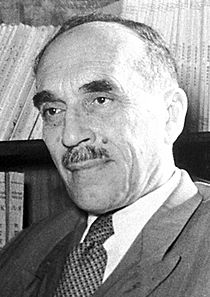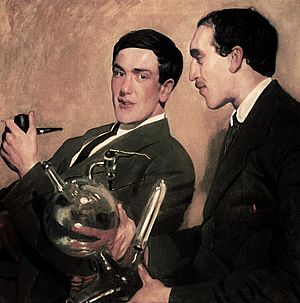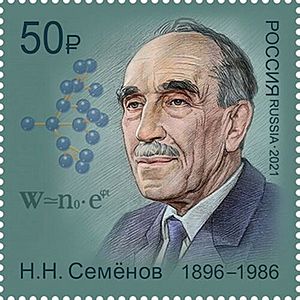Nikolay Semyonov facts for kids
Quick facts for kids
Nikolay Semyonov
|
|
|---|---|

Semyonov in 1956
|
|
| Born |
Nikolay Nikolayevich Semyonov
15 April [O.S. 3 April] 1896 |
| Died | 25 September 1986 (aged 90) |
| Nationality | Russian |
| Known for | chemical transformation |
| Awards | Nobel Prize in chemistry (1956) Lomonosov Gold Medal (1969) |
| Scientific career | |
| Fields | Physics, chemistry |
| Doctoral advisor | Abram Ioffe |
| Doctoral students | David A. Frank-Kamenetskii |
Nikolay Nikolayevich Semyonov (born April 15, 1896 – died September 25, 1986) was an important Soviet physicist and chemist. He is famous for his amazing work on how chemical transformations happen. In 1956, Semyonov won the Nobel Prize in Chemistry for these discoveries.
Contents
Early Life and Education
Nikolay Semyonov was born in Saratov, a city in the Russian Empire. His parents were Elena Dmitrieva and Nikolai Alex Semyonov. He studied physics at Petrograd University from 1913 to 1917. There, he was a student of a famous scientist named Abram Ioffe.
In 1918, Semyonov moved to Samara. During the Russian Civil War, he was part of the White Army.
Scientific Discoveries and Career
Semyonov published his first research paper in 1916. After graduating, he worked as a teacher at the Tomsk University Institute of Technology. In 1920, he returned to Petrograd. He took charge of the electron phenomena laboratory at the Ioffe Physico-Technical Institute. He also became the vice-director of this important institute.
In 1921, Nikolay married Maria Boreishe-Liverovsky, who studied languages. Sadly, she passed away two years later. In 1924, he married Maria's niece, Natalia Nikolaevna Burtseva. They had two children, a son named Yurii and a daughter named Ludmilla.
Measuring Magnetic Fields
In 1922, during a challenging time, Semyonov worked with Pyotr Kapitsa. They found a way to measure the magnetic field of an atomic nucleus. Later, other scientists, Otto Stern and Walther Gerlach, improved this experiment. It became known as the Stern–Gerlach experiment.
Studying Gases and Vapors
In 1925, Semyonov teamed up with Yakov Frenkel. They studied how vapors turn into liquids (condensation) and how they stick to surfaces (adsorption). This work was part of understanding the kinetic theory of gases, which explains how gases behave.
In 1927, Semyonov looked into how ions form in gases. He wrote an important book called Chemistry of the Electron. A year later, in 1928, he worked with Vladimir Fock. Together, they created a theory about how dielectric materials (which don't conduct electricity) can break down from heat.
Leading Research Institutes
Semyonov taught at the Petrograd Polytechnical Institute and became a Professor in 1928. In 1931, he helped start the Institute of Physical Chemistry of the USSR Academy of Sciences. He became its first director. In 1932, he became a full member of the Soviet Academy of Sciences.
Semyonov's ideas have been used in many areas of science. They helped understand how polymerization reactions (making large molecules) happen. His work also helped in studying catalysis, which is how some substances speed up chemical reactions, even in living things.
Nikolay Semyonov passed away on September 25, 1986, in Moscow. He was buried at the Novodevichy Cemetery.
Key Scientific Contributions
Semyonov's most important work was on how chemical transformations occur. He deeply studied the idea of chain reactions from 1934 to 1954. He also looked closely at how these reactions apply to combustion (burning processes).
He came up with a theory called "degenerate branching." This theory helped scientists better understand how oxidation processes (like rusting or burning) start and develop. Semyonov spent most of his career studying and developing the field of chemical chain reactions.
Semyonov wrote two very important books about his work. His book Chemical Kinetics and Chain Reactions came out in 1934. It was the first book in the Soviet Union to explain in detail how unbranched and branched chain reactions work in chemistry. His second major book, Some Problems of Chemical Kinetics and Reactivity, was first published in 1954. It was updated in 1958 and translated into many languages.
He is the only Soviet/Russian chemist to win the Nobel Prize in Chemistry. He shared the prize in 1956 with Sir Cyril Norman Hinshelwood.
Semyonov also trained other scientists, like the Russian chemist Alexandr Shilov. Shilov later discovered how platinum can help activate C-H bonds in molecules.
Awards and Recognition
Nikolay Semyonov received many honors and awards for his scientific work.
- Order of Lenin, nine times (including 1945, 1953, 1956, 1966, 1971, 1976, 1981)
- State Stalin Prize (1941, 1949)
- Honorary Member of the British Chemical Society (1943)
- Order of the Red Banner of Labour (1946)
- Honorary member of the Indian Academy of Sciences (1954)
- Nobel Prize in Chemistry (1956)
- Foreign Member of the Royal Society of London (1958)
- Member of the German Academy of Sciences Leopoldina (1959)
- Honorary member of the Hungarian Academy of Sciences (1961)
- Honorary member of the New York Academy of Sciences (1962)
- Foreign member of the United States National Academy of Sciences (1963)
- Honorary Member of the Romanian Academy (1965)
- Hero of Socialist Labour, twice (1966, 1976)
- Lomonosov Gold Medal (1969)
- Lenin Prize (1976)
- Order of the October Revolution (1986)
- Mendeleev Prize
- Honorary Member of The Soviet Academy of Sciences (1932)
He also received honorary doctorates from several universities around the world. These included Oxford (1960), Brussels (1962), London (1965), Budapest Technical University (1965), and Polytechnic Institute of Milan (1964).
Legacy and Remembrance
Nikolay Semyonov's contributions to science are remembered in many ways:
- In 1990, the IHF RAS (Institute of Chemical Physics) was named after him.
- In 1994, a special plaque was placed on the main building of the St. Petersburg State Polytechnic University to honor him.
- Another memorial plaque is on the A.F. Ioffe Institute of Physics and Technology in St. Petersburg.
- On July 27, 1996, a street in Moscow was named Academician Semenov Street.
- There are also streets named after him in Saratov and Tyumen.
- A memorial plaque is on the house in Moscow where Semyonov spent his last years.
- The Russian Academy of Sciences has a special group dedicated to studying his scientific work.
- An Airbus A321 plane belonging to "Aeroflot" airline is named "N. Semenov."
- On April 5, 2019, a monument to him was put up at the National Research Nuclear University "MEPhI" in Moscow.
- In early April 2022, another monument to Academician Nikolai Semenov was unveiled in Moscow.
See also
 In Spanish: Nikolái Semiónov para niños
In Spanish: Nikolái Semiónov para niños
- Chain reaction
- Chemical kinetics
- Chemical reaction network theory
- Evans–Polanyi–Semenov principle



